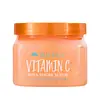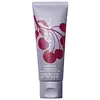What's inside
What's inside
 Key Ingredients
Key Ingredients

 Benefits
Benefits

 Concerns
Concerns

 Ingredients Side-by-side
Ingredients Side-by-side

Sucrose
HumectantGlycerin
HumectantPolysorbate 20
EmulsifyingSilica
AbrasiveAloe Barbadensis Leaf Juice
Skin ConditioningCitrus Paradisi Peel Oil
MaskingCocos Nucifera Shell Powder
AbrasiveButyrospermum Parkii Butter
Skin ConditioningOenothera Biennis Oil
EmollientCitrus Aurantium Dulcis Peel Oil
MaskingMacadamia Ternifolia Seed Oil
EmollientPrunus Amygdalus Dulcis Oil
Skin ConditioningCarthamus Tinctorius Seed Oil
MaskingPersea Gratissima Oil
Skin ConditioningRetinyl Palmitate
Skin ConditioningAscorbic Acid
AntioxidantLactic Acid
BufferingWater
Skin ConditioningParfum
MaskingSorbic Acid
PreservativePhenoxyethanol
PreservativeCaprylyl Glycol
EmollientCI 14700
Cosmetic ColorantCI 15510
Cosmetic ColorantSucrose, Glycerin, Polysorbate 20, Silica, Aloe Barbadensis Leaf Juice, Citrus Paradisi Peel Oil, Cocos Nucifera Shell Powder, Butyrospermum Parkii Butter, Oenothera Biennis Oil, Citrus Aurantium Dulcis Peel Oil, Macadamia Ternifolia Seed Oil, Prunus Amygdalus Dulcis Oil, Carthamus Tinctorius Seed Oil, Persea Gratissima Oil, Retinyl Palmitate, Ascorbic Acid, Lactic Acid, Water, Parfum, Sorbic Acid, Phenoxyethanol, Caprylyl Glycol, CI 14700, CI 15510
Water
Skin ConditioningSucrose
HumectantGlycerin
HumectantHydrated Silica
AbrasiveDisodium Laureth Sulfosuccinate
CleansingDehydroxanthan Gum
Emulsion StabilisingSodium Lauroamphoacetate
CleansingPolyacrylate Crosspolymer-6
Emulsion StabilisingMaltodextrin
AbsorbentPolyglyceryl-10 Oleate
Skin ConditioningPropanediol
SolventMalpighia Punicifolia Fruit Extract
AntioxidantVaccinium Macrocarpon Fruit Extract
AstringentLactobacillus/Punica Granatum Fruit Ferment Extract
Skin ConditioningBromelain
Skin ConditioningPapain
Skin ConditioningCaffeine
Skin ConditioningCitric Acid
BufferingTocopherol
AntioxidantOryza Sativa Bran Extract
Skin ConditioningHelianthus Annuus Extract
EmollientRosmarinus Officinalis Leaf Extract
AntimicrobialRaphanus Sativus Root Extract
AstringentLeuconostoc/Radish Root Ferment Filtrate
AntimicrobialSodium Benzotriazolyl Butylphenol Sulfonate
UV AbsorberPentaerythrityl Tetra-Di-T-Butyl Hydroxyhydrocinnamate
AntioxidantCaprylyl Glycol
EmollientPhenoxyethanol
PreservativeChlorphenesin
AntimicrobialBenzoic Acid
MaskingSodium Benzoate
MaskingSodium Metabisulfite
AntioxidantSodium Hydroxide
BufferingParfum
MaskingCI 17200
Cosmetic ColorantCI 16035
Cosmetic ColorantWater, Sucrose, Glycerin, Hydrated Silica, Disodium Laureth Sulfosuccinate, Dehydroxanthan Gum, Sodium Lauroamphoacetate, Polyacrylate Crosspolymer-6, Maltodextrin, Polyglyceryl-10 Oleate, Propanediol, Malpighia Punicifolia Fruit Extract, Vaccinium Macrocarpon Fruit Extract, Lactobacillus/Punica Granatum Fruit Ferment Extract, Bromelain, Papain, Caffeine, Citric Acid, Tocopherol, Oryza Sativa Bran Extract, Helianthus Annuus Extract, Rosmarinus Officinalis Leaf Extract, Raphanus Sativus Root Extract, Leuconostoc/Radish Root Ferment Filtrate, Sodium Benzotriazolyl Butylphenol Sulfonate, Pentaerythrityl Tetra-Di-T-Butyl Hydroxyhydrocinnamate, Caprylyl Glycol, Phenoxyethanol, Chlorphenesin, Benzoic Acid, Sodium Benzoate, Sodium Metabisulfite, Sodium Hydroxide, Parfum, CI 17200, CI 16035
 Reviews
Reviews

Ingredients Explained
These ingredients are found in both products.
Ingredients higher up in an ingredient list are typically present in a larger amount.
Caprylyl Glycol is a humectant and emollient, meaning it attracts and preserves moisture.
It is a common ingredient in many products, especially those designed to hydrate skin. The primary benefits are retaining moisture, skin softening, and promoting a healthy skin barrier.
Though Caprylyl Glycol is an alcohol derived from fatty acids, it is not the kind that can dry out skin.
This ingredient is also used as a preservative to extend the life of products. It has slight antimicrobial properties.
Learn more about Caprylyl GlycolGlycerin is already naturally found in your skin. It helps moisturize and protect your skin.
A study from 2016 found glycerin to be more effective as a humectant than AHAs and hyaluronic acid.
As a humectant, it helps the skin stay hydrated by pulling moisture to your skin. The low molecular weight of glycerin allows it to pull moisture into the deeper layers of your skin.
Hydrated skin improves your skin barrier; Your skin barrier helps protect against irritants and bacteria.
Glycerin has also been found to have antimicrobial and antiviral properties. Due to these properties, glycerin is often used in wound and burn treatments.
In cosmetics, glycerin is usually derived from plants such as soybean or palm. However, it can also be sourced from animals, such as tallow or animal fat.
This ingredient is organic, colorless, odorless, and non-toxic.
Glycerin is the name for this ingredient in American English. British English uses Glycerol/Glycerine.
Learn more about GlycerinParfum is a catch-all term for an ingredient or more that is used to give a scent to products.
Also called "fragrance", this ingredient can be a blend of hundreds of chemicals or plant oils. This means every product with "fragrance" or "parfum" in the ingredients list is a different mixture.
For instance, Habanolide is a proprietary trade name for a specific aroma chemical. When used as a fragrance ingredient in cosmetics, most aroma chemicals fall under the broad labeling category of “FRAGRANCE” or “PARFUM” according to EU and US regulations.
The term 'parfum' or 'fragrance' is not regulated in many countries. In many cases, it is up to the brand to define this term.
For instance, many brands choose to label themselves as "fragrance-free" because they are not using synthetic fragrances. However, their products may still contain ingredients such as essential oils that are considered a fragrance by INCI standards.
One example is Calendula flower extract. Calendula is an essential oil that still imparts a scent or 'fragrance'.
Depending on the blend, the ingredients in the mixture can cause allergies and sensitivities on the skin. Some ingredients that are known EU allergens include linalool and citronellol.
Parfum can also be used to mask or cover an unpleasant scent.
The bottom line is: not all fragrances/parfum/ingredients are created equally. If you are worried about fragrances, we recommend taking a closer look at an ingredient. And of course, we always recommend speaking with a professional.
Learn more about ParfumPhenoxyethanol is a preservative that has germicide, antimicrobial, and aromatic properties. Studies show that phenoxyethanol can prevent microbial growth. By itself, it has a scent that is similar to that of a rose.
It's often used in formulations along with Caprylyl Glycol to preserve the shelf life of products.
Sucrose is a natural sugar found in fruits, vegetables, and nuts. It is the main constituent of white sugar.
In skincare, sucrose is a humectant and can be a mild exfoliant.
Sucrose is hydrophilic, meaning it attracts water. This makes it an effective humectant and helps hydrate the skin.
Studies show sugars may worsen acne-prone skin due to it disrupting the skin's natural biome. We recommend speaking with a professional if you have any concerns.
In some products such as body scrubs, sucrose is used as an gentle exfoliant.
The term 'sucrose' comes from the french word for sugar, 'sucre'.
Learn more about SucroseWater. It's the most common cosmetic ingredient of all. You'll usually see it at the top of ingredient lists, meaning that it makes up the largest part of the product.
So why is it so popular? Water most often acts as a solvent - this means that it helps dissolve other ingredients into the formulation.
You'll also recognize water as that liquid we all need to stay alive. If you see this, drink a glass of water. Stay hydrated!
Learn more about Water